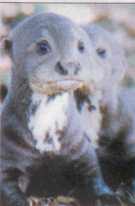Reproduction in the Giant Otter
This is summary of the information about Suriname otters in
Duplaix (1980)
and from
University of Michigan Museum of Zoology,
Otternet of course, and
information formerly available at the
Philadelphia Zoo Website which disappeared when they redesigned it.
Each group, or holt, of Giant Otters is led by a permanently bonded alpha pair, and these are the only ones that reproduce. Breeding can take place throughout the year, but Duplaix (1980) found that in Suriname, cub birth was timed for May, at the start of the dry season, when fish are concentrated in shallow water so hunting is easy. Because of high infant mortality, second litters were sometimes born in December through to April. As a rule, then, mating would take place in February/March.
The female is receptive for 3 to 10 days of her 21-day oestral cycle, signalled by swelling of the nipples and vulva. Mating takes place in the water, with bodies twined vertically, heads upward.
65-72 days later, between 1 and 5 cubs are born in the underground den. The average number is thought to be 2, but there may be undetected mortality in the den, with bodies disposed of unseen. The cubs weigh around 200g at birth, are blind, and have light brown fur, with their indentifying white splodges already showing. Duplaix considered that both parents remain in the den with the cubs.
 At one month old, the pups' eyes open, and they start to come out of the den. By two months
of age, they are being taught to swim and hunt by their mother, and begin eating fish,
though suckling continues till around 5 months. Their fur darkens, and they grow, till
at around 10 months old they look adult, although the scrotum is not
visible in males until they are around one year old.
At one month old, the pups' eyes open, and they start to come out of the den. By two months
of age, they are being taught to swim and hunt by their mother, and begin eating fish,
though suckling continues till around 5 months. Their fur darkens, and they grow, till
at around 10 months old they look adult, although the scrotum is not
visible in males until they are around one year old.
During the early months, the female often decides to move the pups to another den, particularly if disturbed. All the adults help to carry the wriggling, sqealing cubs through the water by their neck fur (not necessarily their scruffs!). Unfortunately, disturbance by tourists can stress the mother so much that her milk fails, and the cubs may starve.
The otters are fully mature at 2 to 3 years, and can live to 13 years in the wild.
| Giant Otter |

